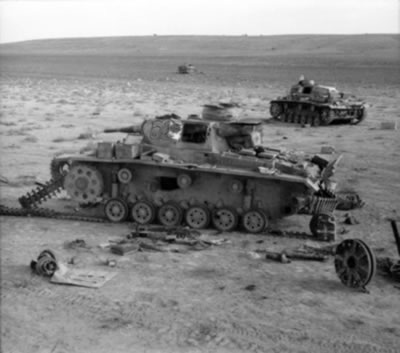
Last updated on February 17th, 2019 at 09:46 pm
Operation Crusader was a British military operation in North Africa during World War II that resulted in the liberation of Tobruk, Libya from Axis forces. Tobruk had been under siege since April 1941.
During Operation Crusader, the British had the advantage of a large reserve of tanks, while the Germans had the advantages of superior communications and a more agile tank force.
Anti-tank weapons played an important role in Operation Crusader.
Operation Crusader was launched on November 19, 1941, after Britain’s Eighth Army had been reorganized.
General Claude Auchinleck, who had been made commander of the British forces in the Middle East after the British defeat at Tobruk, wanted to destroy the panzer formations of the German Afrika Korps by provoking them to attack.
The German Afrika Korps had also been reorganized and included an Italian armored division.
 Tactical commander Lieutenant-General Alan Cunningham led Operation Crusader. When the operation began, Cunningham treated tank warfare as though it were the same as naval warfare, but took place on land instead of on sea – the old way of thinking of tanks as big “landships”. This led him to employ strategies of naval warfare that did not work when engaging enemy tanks and anti-tank weapons.
Tactical commander Lieutenant-General Alan Cunningham led Operation Crusader. When the operation began, Cunningham treated tank warfare as though it were the same as naval warfare, but took place on land instead of on sea – the old way of thinking of tanks as big “landships”. This led him to employ strategies of naval warfare that did not work when engaging enemy tanks and anti-tank weapons.
Cunningham’s troops were not prepared to deal with well-emplaced enemy artillery, or with enemy tanks that could conceal themselves and shoot with only their turrets exposed.
They suffered heavy losses from German artillery and anti-tank guns.
A tank battle between the 4th Armoured Brigade and the 21st Panzer Division resulted in a resounding defeat for the British.
By the end of the first day, the German forces had been able to disperse British armored forces, which were hampered by poor communications.
The following day, November 20, Rommel ordered a counterattack, causing heavy losses for the British.
The Germans attacked another target the day after.
A confrontation between the 4th Armoured Brigade and the rear echelon of the 4th armored division led to another defeat for the British.
The Germans, with better communications, could move faster and with more flexibility than the British could. By November 23, the 4th Armored Brigade had been completely taken out of operations.
Meanwhile, communication among British forces was so poor that many soldiers didn’t know where they were; let alone where the enemy was.
By this time, the British had only a few operational tanks left.
The New Zealand Division, an infantry force, was able to capture the Africa Korps headquarters. However, this did not cause much of a problem for Axis forces.
The commander of the Africa Korps, General Ludwig Crüwell, who had been away from headquarters, was able to coordinate a joint German and Italian counterattack, once again taking advantage of a reliable communication system.
Crüwell committed 150 tanks to the counterattack.
The Axis forces were slowed down when they accidently ran into some British tanks.
After that, they ran into a barrier of British anti-tank guns, which were able to put almost half of he Axis tanks out of action.
Nevertheless, the Germans were able to coordinate a second attack, forcing the British to fall back.
Rommel then used his remaining armored forces to attack the British line of communications.
He wanted to force a withdrawal by threatening the British supply line while at the same time preventing the British from attacking his forward positions.
Rommel then used his two panzer divisions and the Italian Ariete armored division to attack the British line of communications. He wanted to force a withdrawal by threatening the British supply line while at the same time preventing the British from attacking his front line.
Rommel’s forces began their offensive on November 24, hoping to capture the British Xiii infantry corps.
They ran into several British unit headquarters and forced the British to scatter. This led to the British being even more confused.
After five hours, the German had covered 60 miles (95 kilometers).
However, eventually the British were able to slow down the Axis advance with artillery and emplaced anti-tank guns.
Some British forces were able to push forward, some of these reaching Tobruk.
Rommel had to call his panzers back to deal with the situation in his rear, using up fuel and causing his tank force to become worn down.
Meanwhile, the British, who had a large tank reserve, were able to send tanks that had been damaged in battle away to repaired and replace them with other tanks.
Once the British tank force was revived, British armored brigades attacked the 15th Panzer division. However, German anti-tank guns drove them off.
After 17 days of fighting, Rommel was forced to retreat from Tobruk. He withdrew to Gazala, leaving room for British forces to get through to Tobruk.
Eventually, Rommel’s forces pulled back to El Agheila.
The British were not able to cut off the retreat. The agility of the panzers enabled them to strike at British forces and then escape before they could be cut off.
Operation Crusader caused both sides to become more appreciative of the role of anti-tank weapons in breaking up tank attacks.
Rommel reorganized his forces, taking this into account. He arranged his forces so that armored forces, artillery and infantry communicated more closely.
Only weeks after the Axis retreat, Rommel was able to recapture some of the territory that had been lost.
By the end of January 1942, German panzers were only 64 miles (103km) away from Tobruk.
